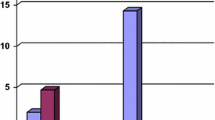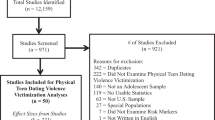Abstract
Objectives Little data exists on dating violence among immigrant adolescents. The present study assessed disparities in experiences of physical and sexual dating violence based on immigrant status and language spoken at home among a large representative sample of adolescent girls.
Methods Data from the 1997–2003 Massachusetts Youth Risk Behavior Surveys (N = 7,970) were analyzed. Adjusted logistic regression analyses were conducted among the full sample and sexually active sub-sample. To further clarify immigration-based effects, separate analyses were conducted within age and racial/ethnic groups.
Results Being an immigrant was found to be protective against dating violence (OR 0.77, CI 0.60–0.98), but not among those reporting sexual intercourse. Stratified analyses revealed important differences in these effects based on age and race/ethnicity; only immigrant girls age 16 or older (OR 0.69, CI 0.48–0.99) and Hispanic immigrant girls (ORs 0.39–0.54) reported reduced risk for dating violence as compared to their non-immigrants peers. No differences in vulnerability to dating violence were detected based on immigrant status for Asian, Black, or White adolescents in stratified analyses.
Conclusions The social context of immigration may offer protection regarding adolescent girls’ vulnerability to dating violence, but effects are not uniform across age, sexual experience, or race and ethnicity. Additional research is needed to understand how immigration, social behavior, age, race and ethnicity may interact to produce disparities in vulnerability to gender-based violence.
Similar content being viewed by others
References
US Census. US Census 2000 Data. American Factfinder. Available at: http://factfinder.census.gov/servlet. Accessed January 29, 2005.
Ku L, Waidmann T. How race/ethnicity, immigrant status and language affect health insurance coverage, access to care and quality of care among the low-income population. Kaiser Family Foundation publication #4132; 2003. Available at: http://www.kff.org. Accessed January 29, 2005.
Granados G, Puvvula J, Berman N, Dowling PT. Health care for Latino children: Impact of child and parental birthplace on insurance status and access to health services. Am J Public Health 2001;91:1806–7.
Lucas JW, Barr-Anderson DJ, Kingston RS. Health status, health insurance, and health care utilization patterns of immigrant Black men. Am J Public Health 2003;93:1740–7.
Casey MM, Blewett LA, Call KT. Providing health care to Latino immigrants: Community-based efforts in the rural Midwest. Am J Public Health 2004;94:1709–11.
Raj A, Silverman JG. Intimate partner violence against South Asian women in Greater Boston. J Am Med Women's Assoc 2002;57(2):111–4.
Raj A, Silverman JG. Immigrant South Asian women at greater risk for injury from intimate partner violence. Am J Public Health 2003;93(3):435–7.
Ayyub R. Domestic violence in the South Asian Muslim immigrant population in the United States. J Soc Distress Homeless 2000;9(3):237–48.
Bauer HM, Rodriguez MA, Quiroga SS, Flores-Ortiz YG. Barriers to health care for abused Latina and Asian immigrant women. J Health Care Poor Underserved 2000;11(1):33–44.
Bui HN, Morash M. Domestic violence in the Vietnamese immigrant community: An exploratory study. Violence Against Women 1999;5(7):769–95.
Chin K. Out of town brides: International marriage and wife abuse among Chinese immigrants. J Comp Fam Stud 1999;25:53–69.
Schaefer J, Caetano R, Clark CL. Rates of intimate partner violence in the United States. Am J Public Health 1998;88:1702–4.
Tjaden P, Thoennes N. Extent, nature, and consequences of intimate partner violence: Findings from the National Violence Against Women Survey. Washington, DC: Department of Justice, National Institute of Justice; 2000.
Frye V, Wilt S, Schomberg D. Female Homicide in New York City: 1990–1997. New York City Department of Health, Department of Health Promotion and Disease Prevention, Domestic Violence Research and Surveillance Unit; 2000. Available at: www.ci.nyc.ny.us/html/doh/pdf/ip/female97.pdf.
Orloff LE. Access to public benefits for battered immigrant women and children. J Poverty Law Policy Clgh Rev 1999:237–56.
Orloff LE, Kelly N. A look at the Violence Against Women Act and gender-related asylum. Violence Against Women 1995;1:380–400.
Raj A, Silverman JG, McCleary-Sills J, Liu R. Immigration policies increase South Asian immigrant women's vulnerability to intimate partner violence. J Am Med Women's Assoc 2005;60(1):26–32.
Raj A, Silverman JG. Intimate partner violence against immigrant women: The roles of immigrant culture, context, and legal status. Violence Against Women 2002;8(3):367–98.
Bui HN. In the Adopted Land: Abused immigrant women and the criminal justice system. Westport, CT: Praeger Publishers; 2004.
Silverman JG, Raj A, Mucci, LA, Hathaway JE. Dating violence against adolescent girls and associated substance use, unhealthy weight control, sexual risk behavior, pregnancy, and suicidality. JAMA 2001;286(5):572–9.
Silverman JG, Raj A, Clements K. Dating violence and sexual risk in a representative sample of high school students. Pediatrics 2004;114(2):e220–5.
Gordon-Larsen P, Harris KM, Ward DS, Popkin BM. Acculturation and overweight-related behaviors among Hispanic immigrants to the US: the National Longitudinal Study of Adolescent Health. Soc Sci Med 2003;57(11):2023–34.
Blake SM, Ledsky R, Goodenow C, O'Donnell L. Recency of immigration, substance use, and sexual behavior among Massachusetts adolescents. Am J Public Health 2001;91(5):794–8.
Kenya S, Brodsky M, Divale W, Allegrante JP, Fullilove RE. Effects of immigration on selected health risk behaviors of black college students. J Am College Health 2003;52(3):113–20.
Aneschenel CS, Becerra RM, Fielder EP, Schuler RH. Onset of fertility-related events during adolescence: a prospective comparison of Mexican American and non-Hispanic white females. Am J Public Health 1990;80(8):959–63.
Hingson SW, Strunin L, Grady M, Strunk N, Carr R, Berlin B, Craven DE. Knowledge about HIV and behavioral risks of foreign-born Boston public school students. Am J Public Health 1991;81(12):1638–41.
Darabi KF, Ortiz V. Childbearing among young Latino women in the United States. Am J Public Health 1987;77(1):25–8.
Brindis C, Wolfe AL, McCarter V, Ball S, Starbuck-Morales S. The associations between immigrant status and risk-behavior patterns in Latino adolescents. J Adolesc Health 1995;17(2):99–105.
Ackard DM, Neumark-Sztainer D. Date violence and date rape among adolescents: associations with disordered eating behaviors and psychological health. Child Abuse Neglect 2002;26(5):455–73.
Howard DE, Wang MQ. Risk profiles of adolescent girls who were victims of dating violence. Adolescence 2003;38(149):1–14.
Unger JB, Gallaher P, Shakib S, Ritt-Olson A, Palmer PH, Johnson CA. The AHIMSA Acculturation Scale: A new measure of acculturation for adolescents in a multicultural society. J Early Adolesc 2002;22:225–51.
Unger JB, Reynolds J, Shakib S, Spruijt-Metz D, Sun P, Johnson CA. Acculturation, physical activity, and fast food consumption among Asian-American and Hispanic adolescents. J Commun Health 2004;29(16):467–80.
Sanderson M, Coker AL, Roberts RE, Tortolero SR, Reininger BM. Acculturation, ethnic identity, and dating violence among Latino ninth-grade students. Prev Med 2004;39:373–83.
Blake SM, Ledsky R, Goodenow C, Sawyer R, Lohrmann D, Windsor R. Condom availability programs in Massachusetts high schools: relationships with condom use and sexual behavior. Am J Public Health 2003;93(6):955–62.
Kann L, Kinchen SA, Williams BI, et al, with State and Local YRBSS Coordinators. Youth Risk Behavior Surveillance–United States 1999. MMWR. June 9, 2000;49,SS5. Available at: http://www.cdc.gov/mmwr/PDF/SS/SS4905.pdf. Accessed January 29, 2005.
Brener ND, Kann L, McManus TL, Kinchen S, Sundberg EC, Ross JG. Reliability of the 1999 Youth Risk Behavior Survey Questionnaire. J Adol Health 2002;31:336–42.
Shah BV, Barnwell BV, Bieler GS. SUDAAN Users Manual and Software, Release 7.0. Research Triange Park, NC: Research Triangle Institute; 1996.
Widmer ED, Treas J, Newcomb R. Attitudes toward nonmarital sex in 24 countries. J Sex Res 1998;35(4):349–58.
Berndt TJ. Developmental changes in conformity to peers and parents. Dev Psych 1979;15:608–16.
Brown BB, Clasen DR, Eicher SA. Perceptions of peer pressure, peer conformity dispositions, and self-reported behavior among adolescents. Dev Psych 1986;22:521–30.
Dekovic M, Wissink IB, Marie-Meijer A. The role of family and peer relations in adolescent antisocial behaviour: comparison of four ethnic groups. J Adolesc 2004;27(5):497–514.
Wu HZ, Berenson AB, Wiemann CM. A profile of adolescent females with a history of sexual assault in Texas: familial environment, risk behaviors, and health status. J Pediatr Adolesc Gynecol 2003;16:207–16.
Author information
Authors and Affiliations
Corresponding author
Rights and permissions
About this article
Cite this article
Silverman, J.G., Decker, M.R. & Raj, A. Immigration-Based Disparities in Adolescent Girls’ Vulnerability to Dating Violence. Matern Child Health J 11, 37–43 (2007). https://doi.org/10.1007/s10995-006-0130-y
Published:
Issue Date:
DOI: https://doi.org/10.1007/s10995-006-0130-y




